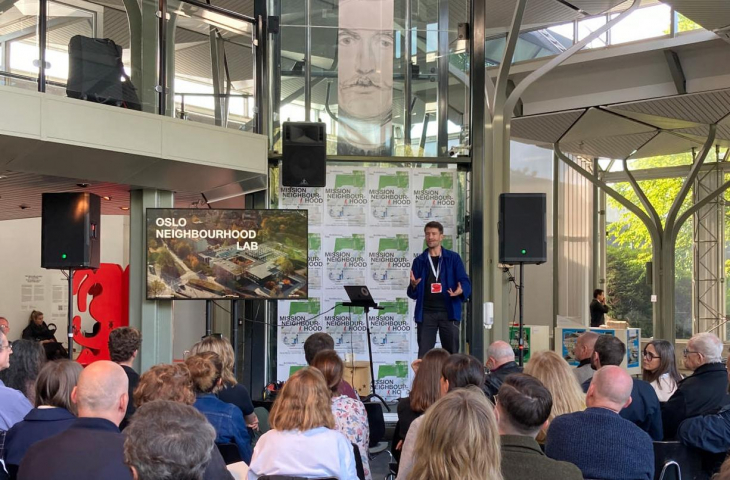We failed by creating neighborhood spaces, we filled cities with "urban nothingness." How did we get to the point where public space became bad? What went wrong? These diagnoses and questions were posed during the opening days of the 8th Oslo Architecture Triennale by its curator Christian Pagh. Following the idea that by repeating the same process it is difficult to count on a different result, a living laboratory was created, a space for experimentation and exchange of ideas. All in order to realize the title "Mission: Neighborhood", to jointly seek solutions and write new scenarios. Because one thing is certain - in order for our neighborhood to change for the better, we need to work together, start acting immediately and also take a little risk.
Are unsuccessful neighborhood spaces really a problem that we should be bending over now? After all, there are far more pressing issues than whether we have a place to meet others. But how do we measure up to climate catastrophe, educate and be the change, if not together? Neighborhoods, after all, are not just the neighborhood closest to us, the better or worse arranged space between buildings, but also (and perhaps most importantly) community, openness, inclusivity, human relationships (and more, as this year's Triennial highlights in many places).
A&B is a media patron of the event
© A&B
Christian Pagh listed five aspects related to neighborhood design and the challenges we face:
- Thequality and diversity of neighborhoods and neighborhoods is threatened by contemporary models of urban planning and urban ownership.
- As an intricate weave of forms and lives, neighborhoods are central to our ability to be (or become) citizens and create communities.
- Shaping neighborhoods is a social issue and must be treated as such.
- Today's planning and building models must be reformulated to include more, more diverse perspectives.
- We need to rethink the processes and models by which we develop (or rather, transform) our urban fabric.
So what would an ideal neighborhood look like according to the event's curator?
Christian Pagh, director and curator of the Oslo Architecture Triennale
The core of OAT is three exhibitions: "Mission Neighborhood - (Re)forming Communities," showing twenty-five projects in six different thematic groups-perspectives (Understanding Places, Social Infrastructure, Our Streets, Nature, Reforming Systems, Alternatives), which we write more about here; "Oslo in the Making," which is a presentation of the results of a multi-stage competition for adesign for the huge post-industrial area of Grønlikaia (you will also read about the various stages of the project and the proposals selected from 118 submissions soon in our pages); "Peter Cook - Ideas of Cities," onwhich through his drawings Peter Cook, British architect and one of the founders of the Archigram group, encourages us to go one step (or even several steps) further in imagining great cities of the future.
Peter Cook in the background of the exhibition of drawings - Ideas of Cities
© A&B
The Triennale is accompanied by various events, workshops, discussions and meetings, as well as exhibitions organized by partner institutions that look at the topic of neighborhoods from different perspectives. One of these is the "Coming into Community" exhibition at the National Museum of Architecture, which tells the story of both inclusivity and exclusion of particular groups.
"Coming into Community" exhibition at the National Museum of Architecture
© A&B
Among other things, the exhibition shows changes in the approach to housing design in the 1960s and 1970s. in Norway, when housing policy ceased to focus exclusively on the nuclear family, the feminist perspective of American architect Phyllis Birkby, whose interests focused on what housing and life could look like if freed from patriarchal ideas, and the London-based Matrix group, which offered free architectural services to marginalized groups in the 1980s. Also seen is the idea of activist Don Jackson, who in the 1960s spearheaded the idea of creating an exclusively gay community in Alpine, California - the Stonewall Nation - and thereby gaining an electoral majority and shaping local politics on his own terms.
Excerpt from the exhibition "Coming into Community"; the Stonewall Nation project
Photo: Børre Høstland © Nasjonalmuseet; drawing: Andreas Harvik © Nasjonalmuseet
The second part of the exhibition was taken over by the Swedish collective MYCKET (consisting of: Katarina Bonnevier, Thérèse Kristiansson, Mariana Alves Silva), which, in line with the idea that "architecture can be used to foster diversity, shape communities and create a worldwhere there is room for everyone," and based on research of queer nightclubs, among others, turned the museum's halls into a welcoming space that encourages interaction and fun - "Heaven by MYCKET."
The exhibition "Heaven by MYCKET"
© MYCKET; photo: Børre Høstland © Nasjonalmuseet
Listen to what its curator, Victoria Bugge Øye, says about the exhibition:
Victoria Bugge Øye, curator of the exhibition Coming into Community
The triennial runs until October 30 this year, and you can find more information on the event's website[here].






















































